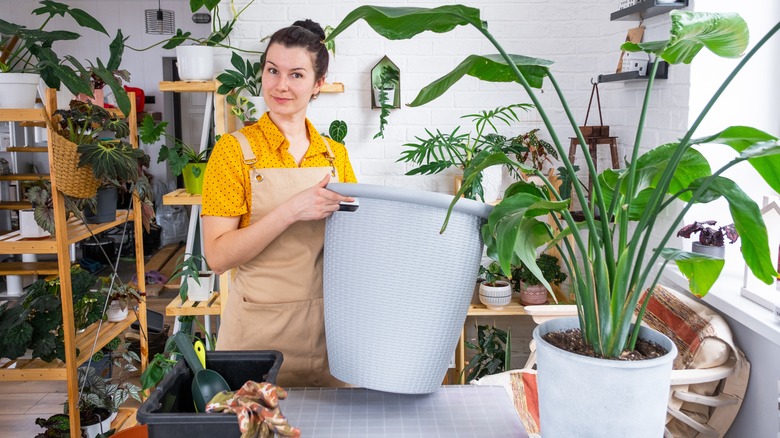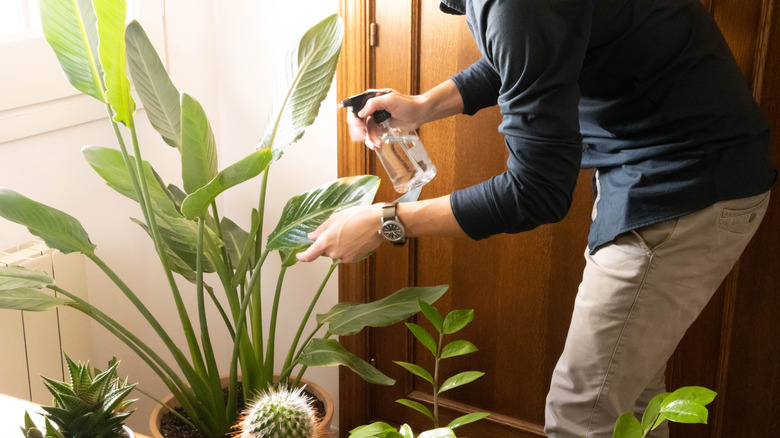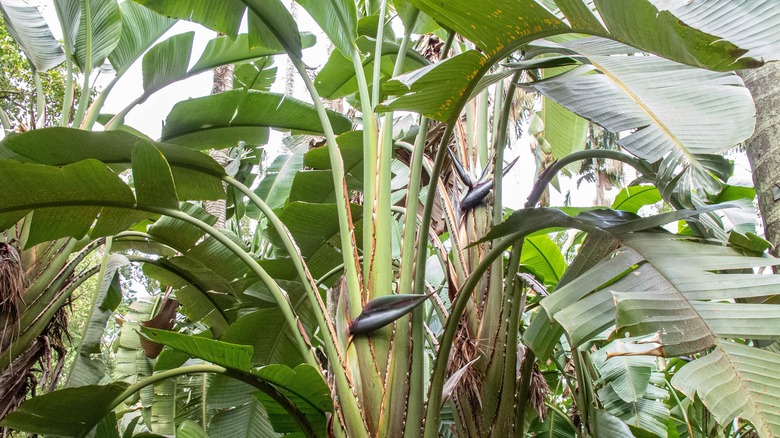Here Are The Perfect Conditions To Grow A White Bird Of Paradise
For those who are looking to reach the pinnacle of their indoor botanical journey, it may be time to consider adding the legendary white bird of paradise plant (Strelitzia nicolai) to your collection of plants. Known to many botanists and plant enthusiasts as the queen of the indoor plant world, the bird of paradise that knows how to rule a room when grown as a houseplant. This large-and-in-charge plant can be grown outdoors, but since it is native to subtropical South Africa, the white bird of paradise can only thrive in USDA zones 9b through 11.
Unless you happen to live in a tropical or subtropical zone, you'll have to settle for growing your white bird of paradise plant as a houseplant (or create your own indoor greenhouse for tropical plants). Either way, you'll need to provide this 7-foot giant with the same conditions it would receive in its native zones: lots of direct light, plenty of humidity, frequent watering, and fertile soil. In areas where you can grow this gem outdoors, it may reach a height of 20 feet! So, if you're up for a bit of a challenge, consider this your guide to growing your very own dazzling white bird of paradise plant.
Growing white bird of paradise indoors
Once you have acquired a white bird of paradise, it's time to start caring for your striking tropical plant. Begin by finding a home (within your home) for your plant that receives an abundance of direct sunlight (6-8 hours per day). If your room can't offer direct sunlight, choosing the perfect grow light will be necessary. Since white bird of paradise plants require subtropical conditions, you'll need to create a humid environment for your plant to thrive. You can accomplish this by creating a trendy humidity tray or by utilizing a humidifier to maintain a humidity level of about 60%.
Your white bird of paradise will need to be watered often. You should provide the plant with more water as soon as the top inch of its soil feels starts to feel dry. If you notice brown edges on its leaves, it may be a sign of mineral sensitivity that will require switching to distilled or rain water. Keep your plant's room between 65 degrees and 70 degrees Fahrenheit during the day and 50 degrees and 55 degrees Fahrenheit at night. Fertilize it monthly during the spring and summer seasons. Then, prepare to be amazed as you watch it grow. Be prepared, however, to enjoy the plant for its tropical foliage, as indoor samples rarely flower.
Growing white bird of paradise outdoors
For those who happen to live in zones 9b through 11, white birds of paradise make excellent ornamental landscaping plants. While outdoor conditions cannot be controlled as tightly as those indoors, outdoor plants have a much higher chance of blooming. The plant's leaves may also take on a shredded appearance outdoors from wind exposure. Plant your white bird of paradise in well-draining soil in a warm (70 degrees Fahrenheit or warmer during the day) spot that receives at least 4-5 hours of direct sunlight per day. During periods of low rainfall in the spring and summer, water the plant whenever the top inch of soil feels dry. During autumn and winter, you can allow the soil to become completely dry before watering is required.
Your bird of paradise will benefit from the addition of a general purpose fertilizer to its soil twice per month during spring and summer. A cool dormant period during the autumn and winter is ideal for this plant, which can tolerate lows as cold as 50 degrees Fahrenheit during colder seasons. Be sure to prune away both flowers and leaves as soon as they start to appear faded in order to promote the growth of healthier foliage and blooms in their place. If you wish to grow more of these unique plants, you can easily propagate white bird of paradise by separating and planting shoots with roots.


